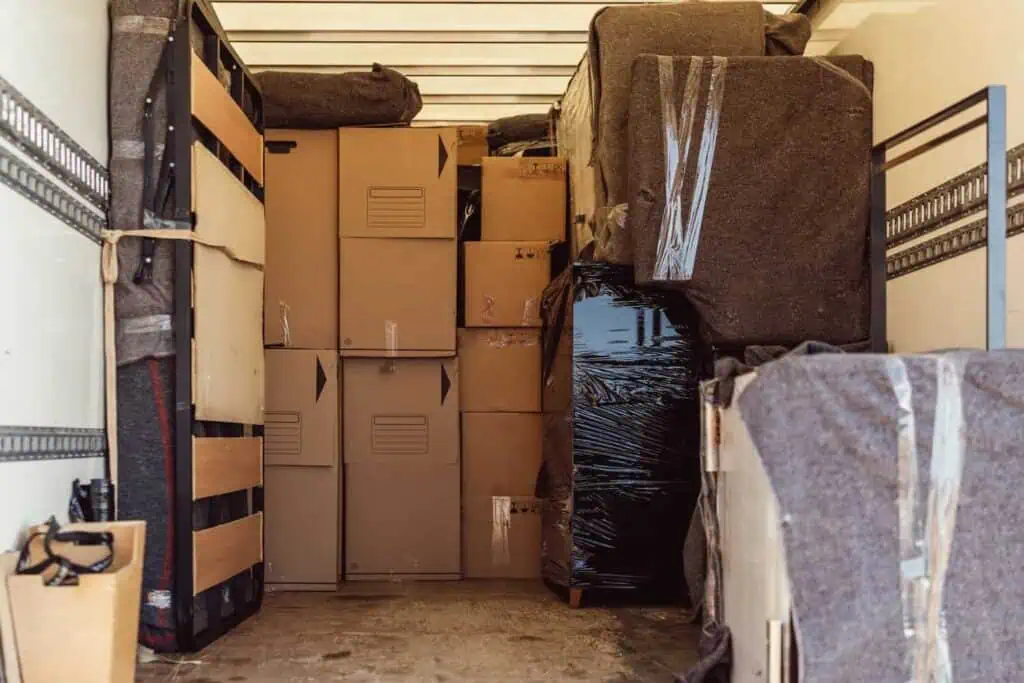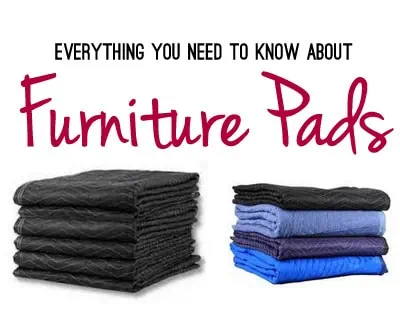If you hire full-service movers, you don’t have to think about whether or not to use moving blankets. Also called furniture pads, those big, thick blankets that movers wrap around your furniture and major appliances usually come as part of the deal.
However, if you decide to rent a truck and DIY your move, those blankets become an optional, added expense. This may leave you wondering if you really need them.
The short answer is yes. You need them, just like the pro movers do. And we’ll walk you through where the best places to get moving blankets are, how much they cost, and more tips to ensure your DIY move goes off without a hitch.
Moving Blankets: What They Are and How They Make a Difference
Moving blankets (AKA furniture pads) are big, thick, heavy squares of quilted cloth and padding. If used properly, they keep your furniture and appliances (and anything else that doesn’t fit in a cardboard box) from getting scratched or irreparably damaged in transit.
While they aren’t cheap, a few $12 moving blankets could actually save you hundreds to thousands of dollars in damages. Imagine your flat-screen TV rubbing against the corners of your antique wooden dresser for hours — that’s why moving blankets are worth it!
Plus, they do more than help prevent scrapes and scratches.
Dust, Dirt & Grease
Moving blankets help protect your appliances and electronics from dust and dirt, especially those with sensitive components. This includes washers, dryers, refrigerators, pianos, microwaves, and speakers. And let’s face it, how often does anyone clean behind and under their sofas and bookcases? Once you start moving all that stuff, you’ll be kicking up months or years of dust and dirt.
“A lot of movers use tape or shrink wrap to keep their pads in place. Others use big rubber moving bands, which are costlier upfront but are reusable and more environmentally friendly.”
You’ll also be disconnecting your washer/dryer, clearing out your garage, boxing up the basement and attic, and tackling the stuff in the yard. In short, moving out is dirty work.
However, taking the time to cover your furniture and major appliances in moving blankets will protect them from the inevitable moving day dust storm and grime.
Save Your Floors
Dragging a dresser across the floor can instantly damage wood, tile, or linoleum. Instead, position the dresser on a furniture pad, which is both safer and easier to move. Of course, it doesn’t work for all furniture. While a dresser with a flat bottom or short, thick feet will slide across the floor nicely when placed on a pad, a dresser with long, spindly legs will break.
Navigating stairs is also much easier with a pad. As long as you have a solid, flat surface to work with, you can wrap an appliance or a piece of furniture in pads and slide it down (or even up) a flight of stairs relatively safely and easily.
Added Stability During Transport
For movers, loading a truck is like a game of Tetris. Not only do they have to make sure everything fits, but it all has to sit snugly. If there are gaps between the boxes and odd-shaped items, your entire load will start to shift during transport.
If your stuff starts moving around back there, that’s when things get damaged. To prevent this, movers wedge rolled-up pads into those spaces and gaps, keeping everything stable and secure.
If you’re packing up your own rental truck, you’ll want to do the same. You could also use blankets, comforters, sleeping bags, and even couch cushions to keep your stuff from shifting. Just make sure you put them in plastic bags first so your bedding or cushions don’t get damaged or dirty.
Where Can I Get Moving Blankets?
As mentioned earlier, furniture pads are part of the deal when you hire full-service movers, and companies like UHaul, Budget, and Penske offer moving blankets as an add-on when you rent one of their trucks.
If you decide to buy moving blankets, there are plenty of options to choose from. Make sure when you’re shopping around that you consider the size and weight of the blankets in addition to price. Here are some of the best we’ve found:
- Amazon offers some of the cheapest blankets, in both price and quality.
- U-Boxes has a large range of moving blankets varying in price and quality.
- New Haven and US Cargo Control sell pads that are generally tougher and geared toward professional use. The price might reflect that, too.
Some types of moving blankets, referred to as burlap pads, moleskin pads, or simply skins, are much thinner, lighter, and usually smaller than regular furniture pads. These are meant to be wrapped around items found in your garage or shed, like rakes and shovels, not your lacquered black walnut dining room set.
Should I rent U-Haul moving blankets instead of buying them?
Considering the number of blankets you’ll need for your move (and the odds of never needing them again), renting may, on the surface, seem more sensible than buying. But if you do rent furniture pads, there are a few things to know:
- Pads for rent are not always the size and quality you’d want or expect.
- Rented pads have very likely been used many times, which can degrade their quality. Also, rental agreements usually require you to return the pads in good condition, or you’ll have to buy them. Take note, and take pictures before you use them.
- Outside of U-Haul, Budget, and Penske, you may be hard-pressed to find a company that rents moving blankets.
As a last resort, you can give online marketplaces a shot. Check eBay or Craigslist for a deal on used (or maybe even new or never used) moving blankets and pads.
Does the weight of the furniture pad matter?
Yes, it does. Price can be one indicator of the quality of a pad, but a much better measure of quality is how heavy it is.
Durable, quality pads weigh in at around 5.5 lb. each, if not more. Cheaper ones are lighter, around 3.5 lb., and noticeably thinner. If they’re that thin, they might not offer full protection, though they can work well for items like patio furniture or bicycles.
How many moving blankets will I need?
There’s a lot of advice out there, sometimes contradictory. Twelve blankets for every bedroom. Twelve to fifteen pads, or maybe twenty-four, for a one-bedroom apartment. Some say you need a dozen pads for every five cubic feet of truck space.
Ignore those “rules.” Instead, get an accurate count by taking note of every item in your house that you’ll need to wrap. Then, you can estimate how many pads you’ll need by understanding how many each furniture item takes to wrap.
Going with the standard 72” x 80” furniture pad, here are the number of pads you’ll need to wrap common household items:
- 1 furniture pad: Nightstand, end table, small bookcase, dining room chair, average-sized flat-screen TV, microwave, small computer stand/table
- 2 furniture pads: Large bookcase, washer, dryer, headboard/footboard, upholstered chair, smallish kitchen/dining room table (one for the tabletop and one for the legs, once you remove them)
- 3 furniture pads: Entertainment unit, armoire, large kitchen/dining table (two for the tabletop and one for the legs), loveseat, refrigerator, large dresser
- 4+ furniture pads: Sofa, piano, hot tub
If you aren’t sure how many pads a piece will require, go high. It’s always better to have too many pads than too few!
Can I use shrink wrap instead of moving blankets?
In short, no, you can’t use shrink wrap instead of moving pads, but it might be a good idea to use it with moving pads.
Shrink wrap is the plastic material that movers sometimes use to wrap furniture. Resembling a huge roll of Saran Wrap, shrink wrap is safe to use on cloth upholstery. However, it can cause irrevocable damage to leather or wood if left for long periods, especially under extreme temperatures. Shrink wrap also tends to trap moisture, leading to mold.
Movers generally use shrink wrap in addition to furniture padding. It helps keep the pads in place and offers extra protection against dust and dirt. Shrink wrap also has a slightly sticky texture, giving you a better grip when carrying heavy items down stairs, through doorways, and onto the truck.
Pro Tip: When pad-wrapping furniture with a glass surface, like a china hutch or curio, wrap a piece of cardboard over the glass with shrink wrap before covering it with a furniture pad. This adds extra protection and signals that there’s glass underneath.
Can I just use old blankets instead of furniture pads?
Technically, yes, but moving blankets are much better at protecting your nice stuff than old blankets.
If you’d like to save some money or effort by using fewer moving blankets, there’s a compromise. Wrap your nice furniture in clean moving blankets and save your old blankets for dirty garage and outdoor items.
Are moving blankets easy to use?
Pad-wrapping a piece of furniture tends to be easier than keeping those pads in place. A lot of movers use tape or shrink wrap, while others use big rubber moving bands, which are more expensive upfront than shrink wrap, but are reusable and environmentally friendly.
“While a dresser with a flat bottom or short, thick feet will slide across the floor nicely when placed on a pad, a dresser with long spindly legs will break.”
Tape is probably your cheapest option. However, shrink wrap is the quickest and best way to get the blankets to stay in place while giving your hands a good grip.
Pro Tip: It’s much easier to handle and haul a shrink-wrapped piece of furniture with your bare hands than with gloves on.
Will my stuff be safe if I use enough moving blankets?
Wrapping up your furniture and appliances in quality pads is a great move and will help keep your stuff safe. But blankets don’t make your things lighter. If loaded onto the truck improperly, your stuff will start tipping and slipping all over the place. When that happens, blankets aren’t enough to save your flat screen. This is why so many people opt to have vetted movers like the professionals at HireAHelper do the heavy lifting and loading for them.
If you want to DIY your move, go for it! Just be sure to stock up on plenty of moving pads — for your furniture, appliances, and a little peace of mind.
How Much Do Moving Blankets Cost?
Moving blankets typically cost anywhere from $8 to $15 each, but the prices can vary widely based on quality, size, and weight. Whether you need one to move heavy furniture down the stairs or several to protect your belongings while loading a PODS container, you have plenty of options.
Consider buying moving blankets online as opposed to in-store for more options and better prices.
| Retailer | Cost | What to Keep in Mind |
| Walmart | $12.86 |
|
| The Home Depot | Starting at $15.98 |
|
| U-Haul | Starting at $8.95 |
|
| Target | $16.99 |
|
| Amazon | Starting at $14.99 |
|
| Lowe’s | $22.98 |
|
| U-Boxes | Starting at $41.19/2-pack |
|
| New Haven | Starting at $36 |
|
| US Cargo Control | Starting at $6 |
|









 Working with a second person below to guide and support the dolly as you descend the stairs is also a good idea. Even a
Working with a second person below to guide and support the dolly as you descend the stairs is also a good idea. Even a 


